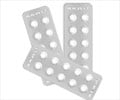Hypertension is one of the most common comorbidities of gout. 74% of patients with gout have hypertension.

To study the risk of incident gout among patients with hypertension and antihypertensive drugs a study was conducted in United Kingdom between January 2000 and December 2007 in which the data was collected from the health improvement network database containing the computerized medical records entered by general practitioners in the United Kingdom. Patients free of gout and cancer were included in the study.
The potential impact of antihypertensive drugs by class: diuretics, β blockers, calcium channel blockers, angiotensin converting enzyme inhibitors, losartan, and non-losartan angiotensin II receptor blockers were evaluated. Dose of antihypertensive drugs were classified into three groups: medium or low (recommended starting doses or lower), high (higher than recommended starting doses), and unknown. From the database data was collected on personal characteristics and lifestyle factors such as alcohol use, smoking, and body mass index, as well as comorbidities such as ischaemic heart disease, hypertension, hyperlipidaemia, renal failure, and heart failure.
The study denoted that in both groups gout was associated with an increased number of visits to a general practitioner, alcohol use, adiposity, ischaemic heart disease, hyperlipidemia, and renal failure. As compared with no use of calcium channel blockers, current use among people with hypertension was associated with a lower risk of developing gout.
The relative risks for individual calcium channel blockers were 0.79 or amlodipine, 0.87 for nifedipine, and 0.86 (0.75 to 0.99) for diltiazem. The relative risks for calcium channel blockers according to duration of use among those with hypertension were 1.04 for less than one year, 0.89 for 1-1.9 years, and 0.77 for two or more years.
In this large general practice cohort representative of the UK population, it was found that use of calcium channel blockers and losartan was associated with a moderately lower risk of incident gout among patients with hypertension.
Calcium channel blockers could increase the glomerular filtration rate and consequently the clearance rates of uric acid and creatinine. These inverse associations were stronger with both a longer duration and a higher dose of use.
Reference: Antihypertensive drugs and risk of incident gout among patients with hypertension: population based case-control study; Hyon et al; BMJ 2012.
Source-Medindia















